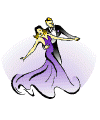|
|
Why Do We Dance Moving Counter
Clockwise?
by Sandi
& Dan Finch
You probably haven’t given that question much thought. I hadn’t, until
I came across the question in the Letters to the Editor in an old
(1966) Ballroom Dancing Times of London.
We learn early on to progress “line of dance,” and that means moving
forward, around the hall, counterclockwise. But, why do we do that?
One letter writer in the 1966 magazine said we do that because the Sun
rises in the east and sets in the west, a counter clockwise
progression. Early man believed strongly in the cycles of nature and
took that course in dance as part of religious rituals.
Luca Barrichi, lecturing on the development of dance frame for
DanceVision last year, said dance movement started to the left in the
Renaissance because men wore swords, mostly on their left hip. To keep
the weapon from knocking into his partner, a man put her on his right
side. From that position, it was easier to follow a leftward arc to
keep it out of her way and so her heavy billowy skirts would swing to
the outside of the circle, out of his way.
One of the 1966 letter writers blamed it on the Anglo-Saxons who ruled
England from 450 to 1066 A.D. In those early days, the writer from
Dudley wrote, gentleman dancers wore a full suit of armor and held the
lady in front of them to cushion the effects of collisions. Counter
clockwise was decreed by Anti-Ethelbert the Bad, who was a Saxon king
for only five years, he said, and the next king didn’t have the heart
to change it. (I could find no internet support for this theory.)
In the courts of the 17th Century, according to Britannica.com, you
always had to dance facing the king because it was considered bad
manners to turn your back on the monarch. The rule of etiquette had to
change to allow a dance to move.
Counter clockwise (CCW) seems like the natural progression. Objects in
our solar system travel counter clockwise—Earth as it moves around the
Sun, the Moon in its orbit around the Earth. An ant walking on a
twining vine will walk CCW whether he is climbing up or down, one New
Zealander posted on the internet.
Horse races in America run counter-clockwise, but that was originally
out of patriotism. English horse races were run clockwise. An Irish
immigrant in Kentucky was so infuriated with the British, he built the
first race track in the colonies in 1787 and purposefully had the
horses run the opposite direction. All tracks adopted that, except
Belmont Park which opened in 1905 running clockwise and didn’t change
until 1921, the year after Man o’War won that race running clockwise.
There are scientific reasons for racing counter clockwise. The
“Coriolis effect” is how the rotation of the earth affects a moving
object—that’s why storms north of the equator spin counter clockwise.
It is believed by some that in a horse, blood is brought through veins
from left to right across the body. Racing counter clockwise assists in
moving the blood faster because of centrifugal force—thus making the
horse run faster. (According to horseracingsense.com)
The Greeks had a more practical reason for racing to the left. Racing
was originally done in chariots, and if the contestants moved CCW, this
would keep the dominant sword hand (for most of them) to the outside in
case the weapon was needed.
In 1896, the start of the Modern Olympics, athletes ran races
clockwise. In 1913, the rule changed so races would run CCW because
“everything in nature tends toward counter clockwise,” according to the
International Educational E-Journal, 2013.
Cowboys mount their horses from the left, NASCAR runs its races CCW,
airport landing patterns circle CCW.
Scientifically, it seems, we dance the direction we do because it’s the
natural thing to do. If you like knowing “why” we do things, that’s not
a particularly satisfying answer.
So the answer I found from one Texan isn’t so far fetched, in light of
the void. In a column on TexasEscapes.com, an online magazine, one
writer suggested we dance leftward because if we danced clockwise, the
same direction we wind a clock, we would soon be wound up too tight to
dance. The columnist agreed he had seen many dancers trying to navigate
the floor, too tight to dance, let alone walk straight.
Two answers in one—now I also know why you shouldn’t drink before you
go dancing.
From a club
newsletter, April 2021,
and
reprinted
in the Dixie Round Dance Council (DRDC)
Newsletter, November 2025. Find a DRDC Finch archive here.

|
